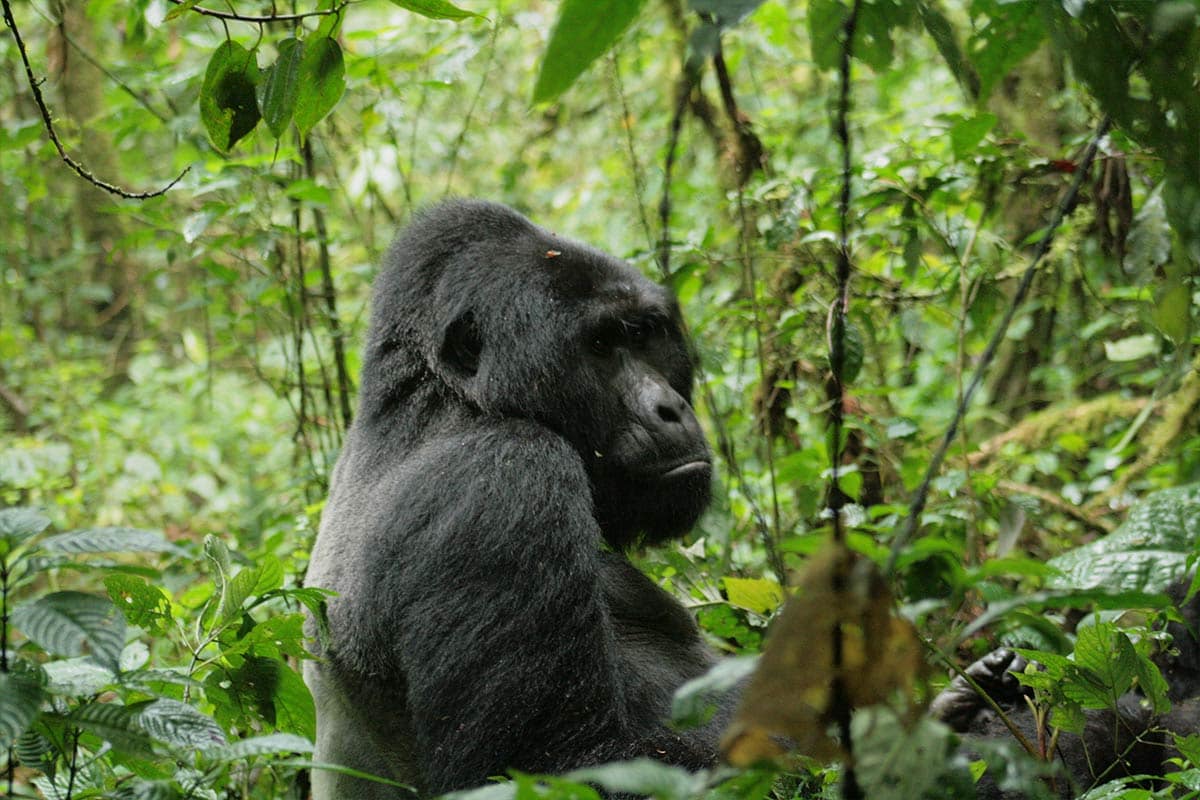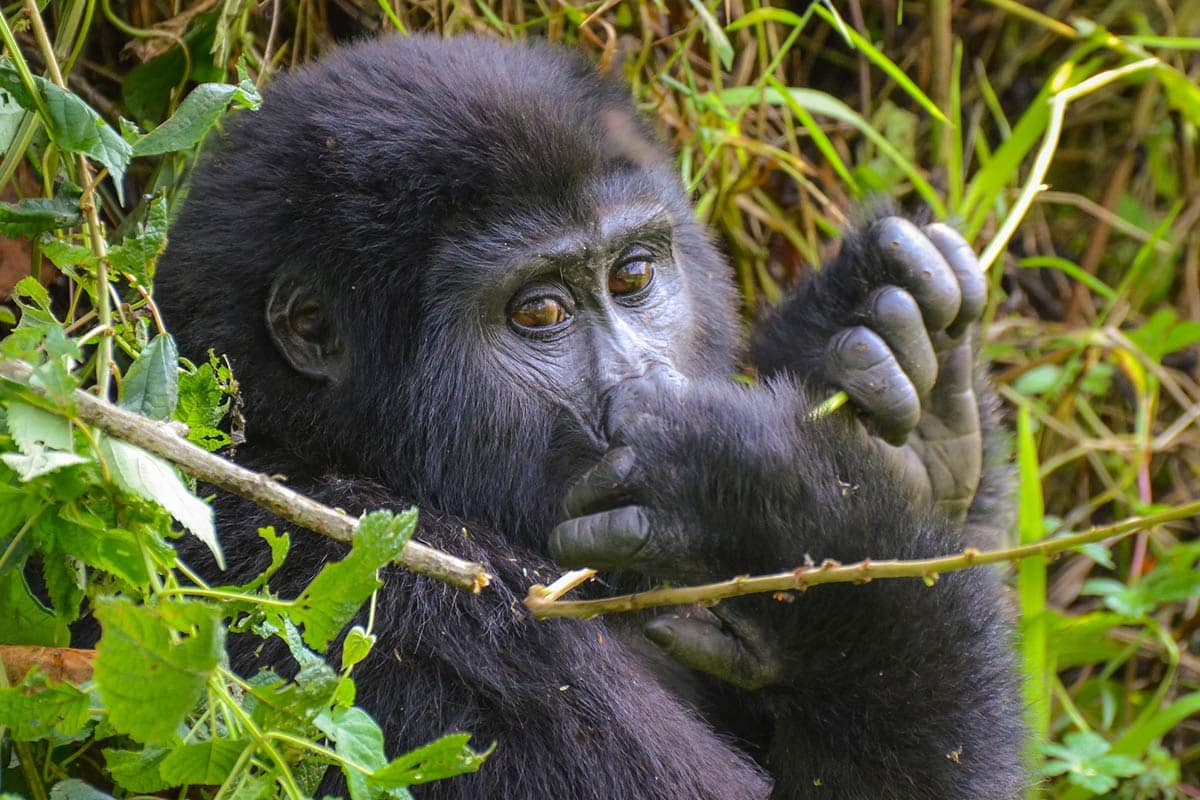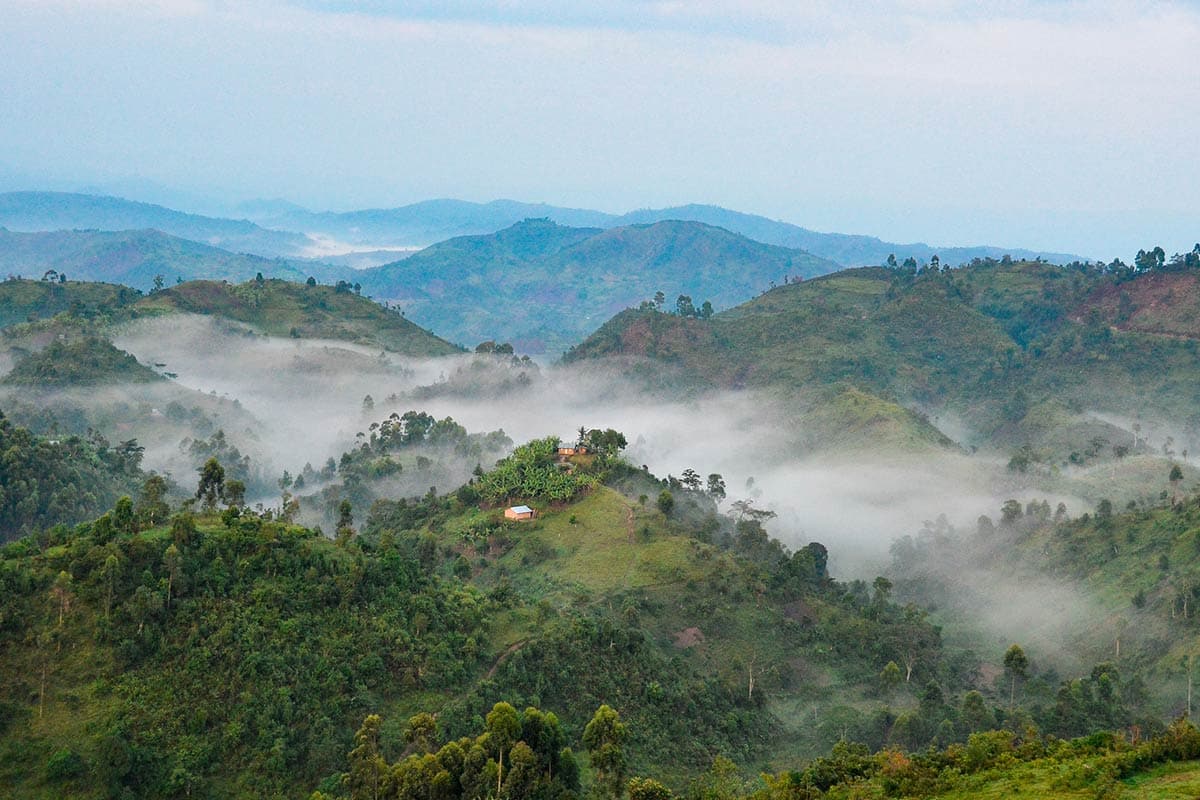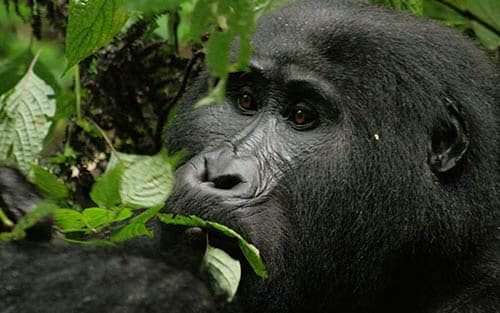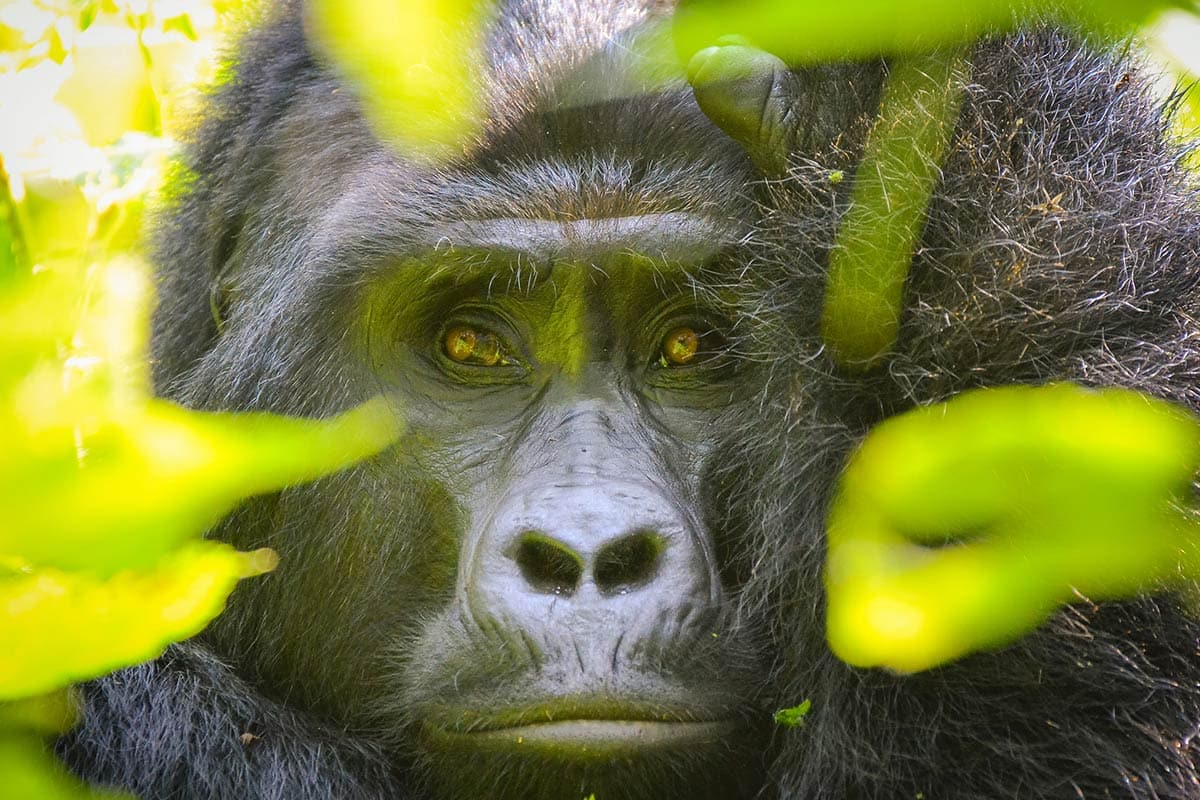
Gorilla Trekking in Uganda: A trip of a lifetime
One male silver back on the left, sitting in a swarm of bugs and munching on some leaves, and a female on the right up in a tree, observing. A little further in and we noticed a baby girl hanging from the tree with her mother. As we watched, baby gorilla and her mother climbed down the tree to settle in a clearing at the base where the baby could take delicious advantage of a bamboo shoot sticking out of the forest floor. On our other side, the dominant male gorilla sat in a different spot, eating leaves and continuously passing gas. And although we were all enamored watching the baby tumble off her mother’s back only to get scooped back up into her warm embrace, or seeing the dominant male flip upside-down to stare at us from a new angle, the gorillas didn’t seem to care one bit that we were there. As the senior guide said, “people are just part of their scenery.”
The gorillas
Have you watched David Attenborough’s 1979 Life on Earth? It’s an all-time television favourite where he breathlessly encounters with mountain gorillas. You should watch it, here’s a clip from daily motion. Back then, the experience of gorilla trekking seemed improbable to any experience traveller, and just as dangerous. Today, thanks to Dian Fossey, we know better: we have nothing to fear from these gentle and highly endangered primates. And visiting them in their natural habitat – the mountain forests of equatorial Africa – has become one of the planet’s ultimate wildlife experiences.
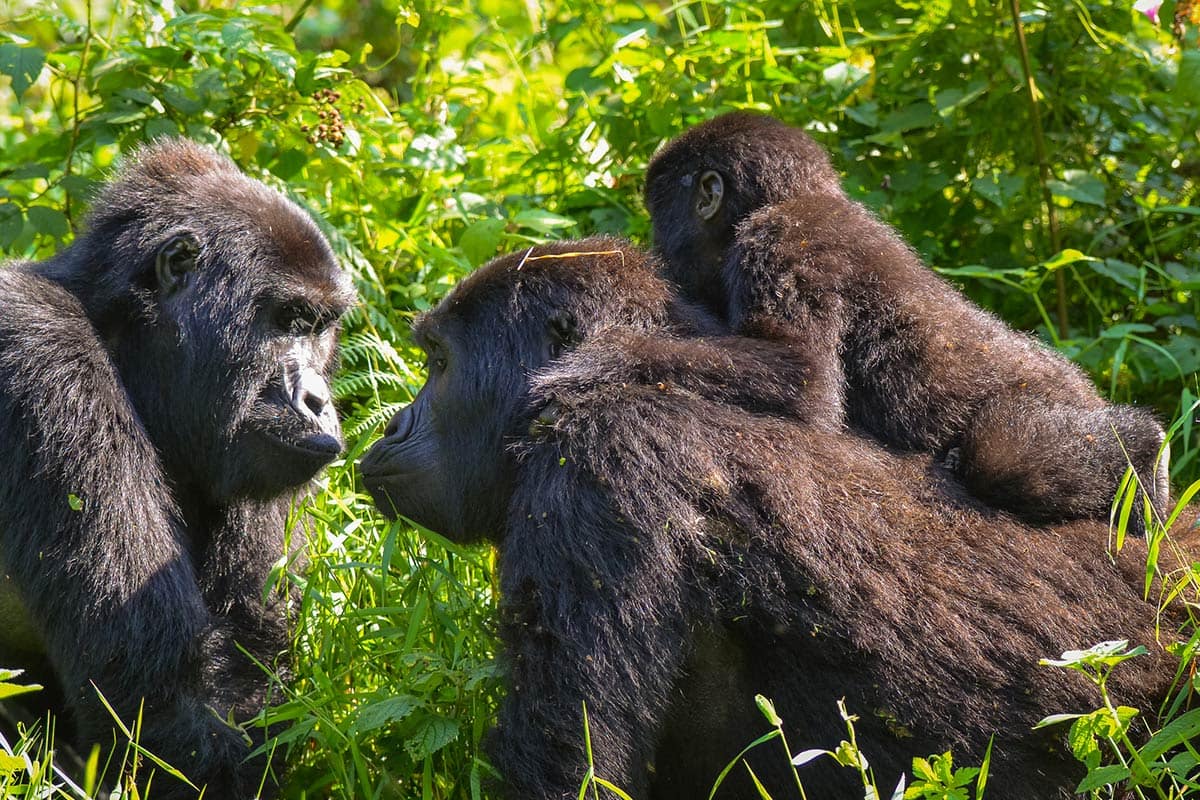
Scientifically speaking, the mountain gorilla is a high-altitude race of the eastern gorilla, the larger of Africa’s two gorilla species, and distinguished by its denser fur, which protects it from the colder highlands climate. It lives in troops of 10-30 individuals, over which a “silverback” male (named for his cape of white hair) presides. This formidable individual, sometimes topping 200kg, seldom uses his great strength in anger. Indeed, gorillas – compared with excitable chimps – are very relaxed animals.
Today the mountain gorilla is confined to the Virungas, a cluster of forested volcanoes that straddle the borders of Rwanda, Uganda and the Democratic Republic of Congo (DRC). It is much rarer than its lowland cousins further west but – thanks largely to American primatologist Dian Fossey, of Gorillas in the Mist fame – much better known. Fossey’s work in Rwanda during the Sixties and Seventies radically changed our perception of these animals and, in the process, paved the way for today’s tourist industry.
The Gorilla Trek
Setting off from the start point of gorilla trekking, you’ll generally hike for at least an hour before you find your gorilla family. In some cases it may be three hours or more. The scenery is stunningly beautiful, the hike is all part of the experience. Be sure to keep your own pace and drink plenty of water. It’s easier than you think to get dehydrated, especially at an altitude of 8,500 ft.
Your rangers will be in radio contact with each other, passing information from the previous day’s sightings and helping guide you to the right place.
As you come within range, the rangers will ask you to leave your bags so you can approach the gorillas more closely.
Once you make contact you’ll spend an hour with the gorillas. They may be munching on bamboo, hanging from the trees, grooming each other, suckling their babies, playing, sleeping, farting or mating. Every experience is unique. Take time to enjoy their presence. Remember to come out from behind the camera lens.
If the gorillas are on the move you’ll be able to move with them — keeping the required minimum distance of seven metres at all times. They may show some interest and approach your group. This is normal and nothing to be concerned about. If they approach you, the rangers will ask you to remain calm and step back slowly.
Your guides will explain the rules. You should keep quiet and still and preserve a distance of seven metres – although there’s nothing to stop the apes approaching you. Generally, nothing much happens: the gorillas are dozing or feeding, with some occasional rough and tumble among boisterous youngsters. The silverback is awesome to behold but nothing to worry about. If feeling tetchy, he may beat his chest or make a brief “mock” charge. This sets the pulse racing but you need only keep still, avoid eye contact and let his bluster burn out. Your guides will be in control.
Gorilla trekking is, above all, an intimate experience – more like entering a family sitting room than racing around on safari. Once you have got your snaps, you can enjoy the privilege of observing an extraordinary animal close-up. One hour is not enough, but it is an hour that you will remember for the rest of your life.
The Gorilla Encounter
If a friend told you that they’ll be taking you on a safari that will bring you very close, on foot, to wild beasts capable of mauling you, I’m not sure you’d care to be on it.
One second you are bushwhacking through thickets of bamboo in Uganda’s Bwindi Impenetrable Forest, pulling yourself up a steep jungle slope, toehold to toehold. The next, you turn a corner and sunlight streams through the canopy to illuminate a matted clump of black against a curtain of rain forest green. You’ve known this was coming and still you gasp. Seated perhaps 30 feet away is one of the roughly 1000 mountain gorillas remaining on earth, a saggy-breasted female, and soon you see that she is cradling an infant in her lap. She wraps one arm around the 6-month-old while scratching her own ear with an extended index finger.
She is the advanced sentry for the a gorilla family, a clan of 22, and to the extent that she seems to care at all about your arrival, her attitude smacks of “What took you so long?” You freeze, then tiptoe forward to give all eight trekkers in our group a clear sightline. Cameras are unholstered faster than six-shooters at a gunfight.
Soon two siblings tumble out of the brush, abruptly disrupting the maternal one-on-one time. As the imps wrestle and roll, the mother flops on her back in surrender.
Any anthropomorphism must be forgiven; it is impossible not to be struck by the humanoid nature of these neighbors on the evolutionary chain. While observing so much of African wildlife — warthogs, elephants, giraffes — one marvels at their prehistoric form and questions our placement in the same biological class. With the mountain gorillas of Uganda, which share 98 percent of our DNA, we are looking into a mirror, and they are looking impassively back.
Where to Trek Gorillas
As their name implies, mountain gorillas inhabit forests high in the mountainous regions of East Africa. Their small population is split in two, with just over half living in the Virunga Mountains, bordering Uganda, Rwanda and the Democratic Republic of the Congo, and the remainder in the Bwindi Impenetrable National Park in Uganda.
Rwanda’s gorillas live in Volcanoes National Park (Parc National des Volcans), about two hours’ drive north west from the capital Kigali. Gorilla Trekking can be done over a stay of just two nights, though another night will allow you to relax and explore further. All Rwanda gorilla treks start from park HQ in the village of Kinigi.
Uganda’s gorillas are just over the border in Bwindi Impenetrable National Park, a full day’s drive from Entebbe or Kampala. Allow three nights. Uganda gorilla treks start from four different points, several hours’ drive apart. This will determine which lodge you stay in.
Rwanda offers the easier trekking: your chances of a shorter hike are higher and you will have more flexibility on the day, with rangers allocating groups to troops according to fitness levels. In Uganda the hikes are often longer and steeper, although some prefer this “wilder” challenge.
Permit costs in Uganda (US $600 per person) are cheaper than in Rwanda (US$1,500 per person). Revenue from permits helps fund both gorilla protection and community support; porters and refreshments cost extra.
You’ll also need to budget for visa fees (US$50), transfer and a local service fee (approx USD 120-150) and any re-entry visas. The reason that the permits are so costly is because each park only issues 10 permits per gorilla family per day, to ensure that the gorillas’ exposure to humans is limited. 100% of the permit cost is used by the government to help finance patrols that are instrumental in protecting these apes from poachers and their lethal snares.
On our Uganda safaris, gorilla trekking is an optional activity and the cost of the permit, transfer and local service fee is paid within the price of the Tour Package to save you from the bureaucratic processes.
When To Go
Mountain gorillas can be seen year-round, therefore the best time for gorilla trekking is ultimately up to you. The dry seasons, from mid-December to February and from June to September, are considered the most comfortable times for trekking and the trails are in better condition.
However, there are some advantages of trekking in the wet seasons (March to May and October to December). During these months, gorillas tend to stick to the lower slopes as food is plentiful and temperatures are milder, therefore gorilla trekking times can be much shorter.
What to pack
Most people taking part in a gorilla trek take a small daypack to carry their water supply, food and camera equipment. Here are some other items we recommend packing for your gorilla trekking experience in Uganda.
Comfortable hiking/walking boots: As you’ll most likely be trekking for a few hours to reach the gorillas, a good pair of boots is essential.
Trousers and a long-sleeved shirt: You’ll be ‘bushwhacking’ into a misty rainforest, so wear trousers and a long-sleeved shirt to protect yourself from the thick undergrowth and nettles.
Gloves: A pair of gloves will protect your hands when grabbing branches and vines, particularly a tough pair of gardening gloves.
Light rain jacket: Even if you’re visiting during the dry season, it’s a good idea to pack a light rain jacket. These tropical forests can be damp and there can still be rainfall.
What other experiences
Uganda is an excellent safari destination and wildlife hotspots include Queen Elizabeth National Park (big game safari drives) and Kibale Forest (chimps trekking). Other attractions include Murchison Falls National Park. Rwanda’s more limited attractions include the beautiful Lake Kivu, and Nyungwe Forest, a haven for chimps and other wildlife. For a full Big Five experience, you can combine your Uganda gorilla trekking with a big game safari in one of the parks in Uganda or the neighboring Kenya big gam drama.
Useful Links
Uganda Tourist Visa
Rwanda Tourist Visa
How to see mountain gorillas


